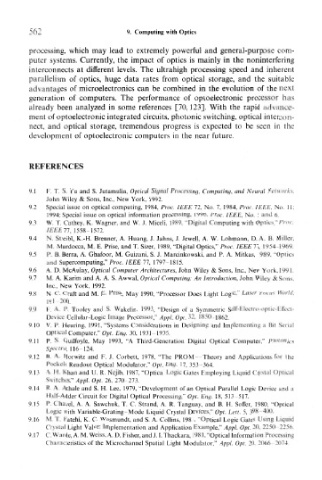Page 577 - Introduction to Information Optics
P. 577
562 9. Computing with Optics
processing, which may lead to extremely powerful and general-purpose com-
puter systems. Currently, the impact of optics is mainly in the noninterfering
interconnects at different levels. The ultrahigh processing speed and inherent
parallelism of optics, huge data rates from optical storage, and the suitable
advantages of microelectronics can be combined in the evolution of the next
generation of computers. The performance of optoelectronic processor has
already been analyzed in some references [70,123]. With the rapid advance-
ment of optoelectronic integrated circuits, photonic switching, optical intercon-
nect, and optical storage, tremendous progress is expected to be seen in the
development of optoelectronic computers in the near future.
REFERENCES
9.1 F. T. S. Yu and S. Jutamulia, Optical Signal Processing, Computing, and Neural Networks.
John Wiley & Sons, Inc., New York, 1992.
9.2 Special issue on optical computing, 1984, Proc. IEEE 72, No. 7, 1984, Proc. IEEE, No. 11;
1994; Special issue on optical information processing, 1996, Proc, IEEE, No. 5 and 6.
9.3 W. T. Cathey, K. Wagner, and W. J. Miceli, 1989, "Digital Computing with Optics." Proc.
IEEE 77, 1558-1572.
9.4 N. Streibi, K.-H. Brenner, A. Huang, J. Jahns, J. Jewell, A. W. Lohmann, D. A. B. Miller,
M. Murdocca, M. E. Prise, and T. Sizer, 1989, "Digital Optics," Proc. IEEE 77, 1954 1969.
9.5 P. B. Berra, A. Ghafoor, M. Guizani, S. J. Marcinkowski, and P. A. Mitkas, 1989, "Optics
and Supercomputing," Proc. IEEE 11, 1797 1815.
9.6 A. D. McAulay, Optical Computer Architectures, John Wiley & Sons, Inc., New York, 1991.
9.7 M. A. Karim and A. A. S. Awwal, Optical Computing: An Introduction, John Wiley & Sons,
Inc., New York, 1992.
9.8 N. C. Craft and M. E. Prise, May 1990, "Processor Does Light Logic," Laser Focus World,
191 200.
9.9 F. A. P. Tooley and S. Wakelin, 1993, "Design of a Symmetric Self-Electro-optic-Effect-
Device Cellular-Logic Image Processor," Appl. Opi. 32, 1850-1862.
9.10 V. P. Heuring, 1991, "Systems Considerations in Designing and Implementing a Bit Serial
Optical Computer," Opt. Ena. 30, 1931 1935.
9.11 P. S. Guilfoyle, May 1993, "A Third-Generation Digital Optical Computer," Photonics
Spectra, 116 124.
9.12 B. A. Horwitz and F. J. Corbett, 1978, "The PROM- Theory and Applications for the
Pockels Readout Optical Modulator," Opt. Eng. 17, 353 364.
9.13 A. H. Khan and U. R. Nejib, 1987, "Optical Logic Gates Employing Liquid Crystal Optical
Switches," Appl. Opt. 26, 270 273.
9.14 R. A. Athale and S. H. Lee, 1979, "Development of an Optical Parallel Logic Device and a
Half-Adder Circuit for Digital Optical Processing," Opt. Eng. 18, 513-517.
9.15 P. Chavel, A. A. Sawchuk, T. C. Strand, A. R. Tanguay, and B. H. Soffer, 1980, "Optical
Logic with Variable-Grating-Mode Liquid Crystal Devices," Opt. Lett. 5, 398-400.
9.16 M. T. Fatehi, K. C. Wasmundt, and S. A. Collins, 1981, "Optical Logic Gates Using Liquid
Crystal Light Valve: Implementation and Application Example," Appl. Opt. 20, 2250 2256.
9.17 C. Warde, A. M.Weiss, A. D. Fisher, and J.I. Thackara, 1981, "Optical Information Processing
Characteristics of the MicroChannel Spatial Light Modulator," Appl. Opt. 20, 2066 2074,

